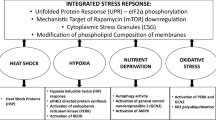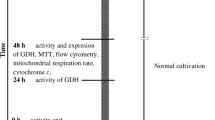Intracellular glutathione (GSH) concentrations were titrated in Chinese hamster ovary cells by exposure to various concentrations of diethylmaleate (DEM). The various steady state levels of GSH obtained were maintained throughout the experimental time course. Cells were incubated at 42° after DEM addition in order to produce thermal dose response curves using colony formation as the end point. The slope of the dose response curve was subsequently determined and compared to the intracellular GSH concentration. This comparison indicated Chinese hamster ovary cells contain multiple reservoirs of GSH which in turn regulate thermal toxicity in a stepwise manner. Removal of 50% or less of the GSH did not affect thermal sensitivity. A small increase in sensitivity occured when 50 to 80% of the GSH was removed. Removal of greater than 80% of the GSH increased thermal toxicity significantly. The facts that 10 and 20 µM DEM produce extensive GSH depletion and only small changes in survival imply that a threshold concentration of GSH must be removed before thermal toxicity is affected.
Similar content being viewed by others
Abbreviations
- BCNU:
-
1-3-Bis(2-Chloroethyl)-1-nitrosourea
- BSO:
-
buthionine sulfoximine
- CHO:
-
Chinese hamster ovary
- DEM:
-
diethylmaleate
- DMSO:
-
dimethyl sulfoxide
- HBSS:
-
Hanks balanced salt solution
- RF:
-
radiofrequency
References
BOAG, J.W. (1975). The statistical treatment of cell survival data. In: Cell Survival after low doses of Radiation: Theoretical and Clinical Implications (T. Alper, ed.) pp 40–53, The Institue of Physics, Wiley, NY.
BABSON, J.R., ABELL, N.S., and REED, D.J. (1981). Protective role of the glutathione redox cycle against adriamycin-mediated toxicity in isolated hepatocytes. Biochem. Pharm. 30:2299–2304.
DIMONTE, D., BELLOMO, G., THOR, H., NICOTERA, P., and ORRENIUS, S. (1984). Menadione-induced cytotoxicity is associated with protein thiol oxidation and alteration in intracellular Ca2+ homeostasis. Arch Biochem. Biophys. 235:343–350.
FARISS, M.C. and REED, D.J. (1983). Measurement of glutathione and glutathione disulfide efflux from isolated rat hepatocytes. In: Characterization and use of hepatocytes (R.A. Harris and N. W. Cornell, eds.) pp 349–55, Elsevier/ North-Holland Biomedical Press, Amsterdam.
FREEMAN, M.L., MALCOLM, A.W. and MEREDITH, M.J. (1985). Decreased intracellular glutathione concentration and increased hyperthermic cytotoxicity in an acid environment. Cancer Research 45:504–508.
GAUDEMER, Y. and LATRUTTE, N. (1975). Evidence for penetrant and non-penetrant thiol reagents and their use in the location of rat liver mitochondrial D(−)-B-hydroxybutyrate dehydrogenase, FEBS Lett. 54, pp 30–34.
GUFFY, M.M., ROSENBERGER, J.A., SIMON, I., and BURNS, C.P. (1982). Effect of cellular fatty acid alteration on hyperthermic sensitivity in cultured L1210 murine leukemia cells. Cancer Res. 42:3625–3630.
LEPOCK, J.R., CHENG, K.H., AL-QYSI, H., and KRUUV, J. (1983). Thermotropic lipid and protein transitions in Chinese hamster lung cell membranes: Relationship to hyperthermic cell killing. Canadian J. Biochem and Cell Biol. 61:421–427.
LIN, P.S., KWOCK, L., and BUTTERFIELD, C.E. (1979). Diethyldithiocarbamate enhancement of radiation and hyperthermic effects on Chinese hamster cells in vitro. Radiation Res. 77:501–511.
MEREDITH, M.J. and REED, D.J. (1982). Status of the mitochondrial pool of glutathione in the isolated hepatocyte. J. Biol. Chem. 257:3747–3753.
MEREDITH, M.J. and REED, D.J. (1983). Depletion in vitro of mitochondrial glutathione in rat hepatocytes and enhancement of lipid peroxidation by adriamycin and 1,3-Bis(2Chloroethyl)-1-nitrosourea (BCNU). Biochem. Pharm. 32:1383–1388.
MITCHELL, J.B., RUSSO, A., KINSELLA, J.J., and GLALSTEIN, E. (1983). Glutathione elevation during thermotolerance induction and thermosensitization by glutathione depletion. Cancer Res. 43:987–991.
ROMERO, F.J. and SIES, H. (1984). Subcellular glutathione contents in isolated hepatocytes treated with L-buthionine sulfoximine. Biochem. Biophys. Res. Comm. 123:1116–1121.
YATVIN, M. B. (1977). The influence of membrane lipid composition and procaine on hyperthermic death of cells. Int. J. Radiat. Biol. 32:513–521.
YAU, T.M. (1979). Procaine-mediated modification of membranes and of the response to x irradiation and hyperthermia in mammalian cells. 80:523–541.
Author information
Authors and Affiliations
Rights and permissions
About this article
Cite this article
Freeman, M.L., Malcolm, A.W. & Meredith, M.J. Glutathione pool size affects cell survival after hyperthermic treatment. Cell Biol Toxicol 1, 213–221 (1985). https://doi.org/10.1007/BF00120165
Received:
Accepted:
Issue Date:
DOI: https://doi.org/10.1007/BF00120165




